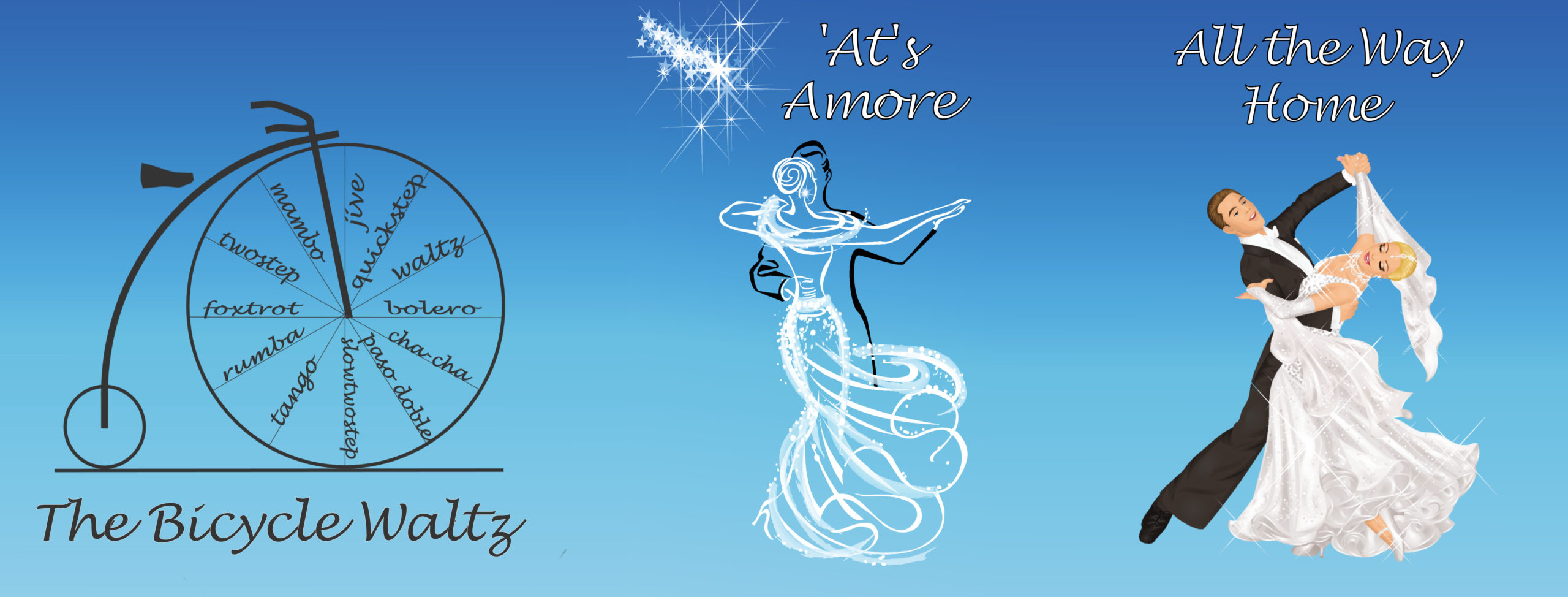Ever since we first discovered round dancing, we’ve been trying various ways to publicize it. The book began with a casual reference by Jean that “somebody ought to write a book or make a movie about round dance.” We talked halfheartedly about trying to contact some author about the idea, but nothing ever came of it. Then one day, Jean said to Paul, “or you could write it.” Paul laughed off the idea at the time, but the seed was planted.
It’s one thing to think, “I’d like to write a book,” and quite another to actually come up with a story and characters. The potential was surely there – plenty of opportunity for interesting characters and romance. But nothing felt right. And there things remained for a long time. Then one day we were at the Golden State Dance Festival watching Rey and Sherry Garza teach. They were engaged in their usual friendly, teasing banter, and the idea crossed Paul’s mind, “What if you had a couple like that, but they were divorced?”. They’d still have to continue with the festival commitments, doing their best not to let it show. Maybe there was a story there?
This idea bounced around in Paul’s head for a while, but there still wasn’t enough there for a novel. Then Alan “introduced himself” (it was about that time that the characters began to take shape and feel like people). The story went off in a different direction, and a rough outline of what would become The Bicycle Waltz began to form. Finally, Paul spilled the idea to Jean, who picked it up and began to run with it. Pretty soon, we were swapping story lines and scene ideas across the kitchen table, and we finally had a story we could get excited about.
But we still didn’t think seriously about writing a book ourselves. Putting all that work into something that might only get rejected by a publisher had little appeal. We were having fun making up the story, but we didn’t really expect anything to come of it. Then one day, Paul stumbled on an article online about indie publishing through Amazon. Suddenly, the project became real.
There was still the question of the actual writing. Paul has a lot of writing experience, but it’s all non-fiction – technical articles and such. He was very much afraid that, in his hands, our wonderful story could turn into a 500 word essay, pruned to the bare essentials. So, one day, he locked himself in his office and experimented. He wrote drafts of “Alan’s First Lesson” and “Silver State”. He took word counts, plugged them into a spreadsheet, and added estimates for other chapters. A little research about the proper length for a novel showed we were at least in the ballpark. OK, here we go…
The next couple of months were a blast. We spent every waking hour on the book (and more than a few non-waking hours!). Much to his surprise, Paul actually enjoyed the writing part. Once you get to know the characters, you can put them into a situation in your head, and then you just transcribe what happens. It was fun.
Then one day, it happened. Paul had the experience that all writers talk about but non-writers never believe. The characters surprised him. Alan and Brandon were in the back of the dance hall, heads together, working on something, but Paul didn’t know what. Shelly went on break and approached to ask what they were working on. Suddenly, Brandon jumps up and says, “Auntie Shelly, look, Alan is teaching me how to draw Calvin and Hobbes!”. Say what? Alan can draw? “Well, I’m no Rembrandt,” says Alan, and then proceeds to explain about how he and his siblings used to draw C&H cartoons of their own. All of this with no conscious thought on Paul’s part. There’s a lot of personal experiences in the book, but not this. It had never occurred to Paul that someone might draw their own C&H strips. It was all Alan’s idea. He’s a creature of my imagination, and yet he’s real. Weird, huh?
Jean spent a lot of her time toning Ray down, softening his edges, and, well, shutting him up. Ray’s a talkative guy. If you think he goes on a bit too much during class now, you should have seen the early drafts. And he was originally a bit edgier in his comments. Jean’s Ray is better (even if Paul did call him “Milquetoast Ray”!).
The last month or so before publication was a little harder. It was still fun when we had a great new idea, but most of the time is was slogging through the hard work of detailed editing – tussling over word selection and trying to get the scenes just right.
At last, it’s done. We hope that you enjoy reading it as much as we enjoyed writing it. And we really hope it will lead non-dancers to ask themselves, “what’s this round dancing thing?”
– Paul and Jean Zimmer, November, 2014
